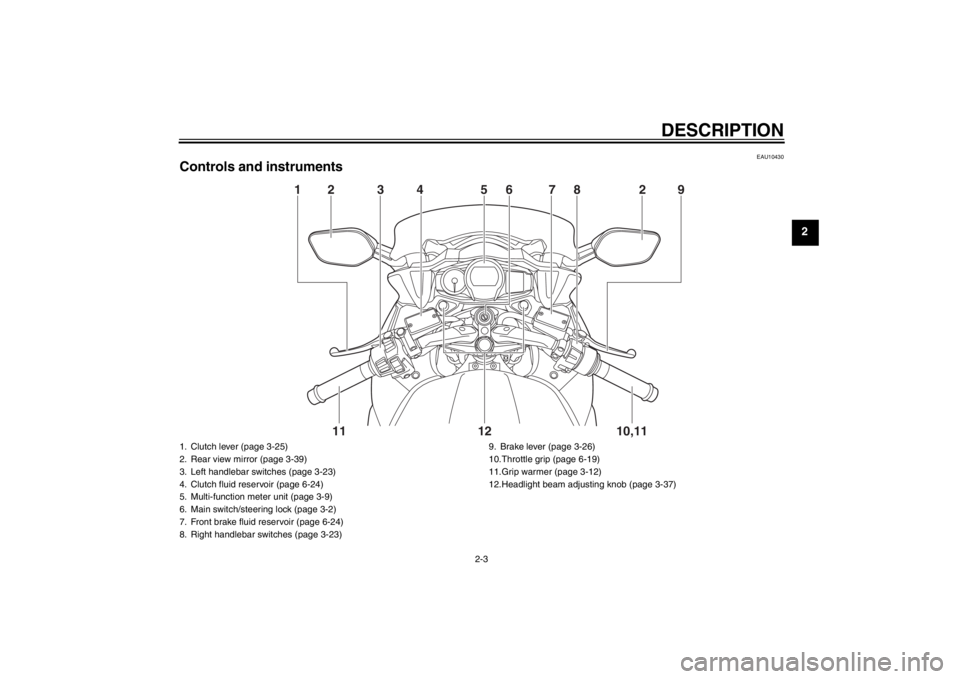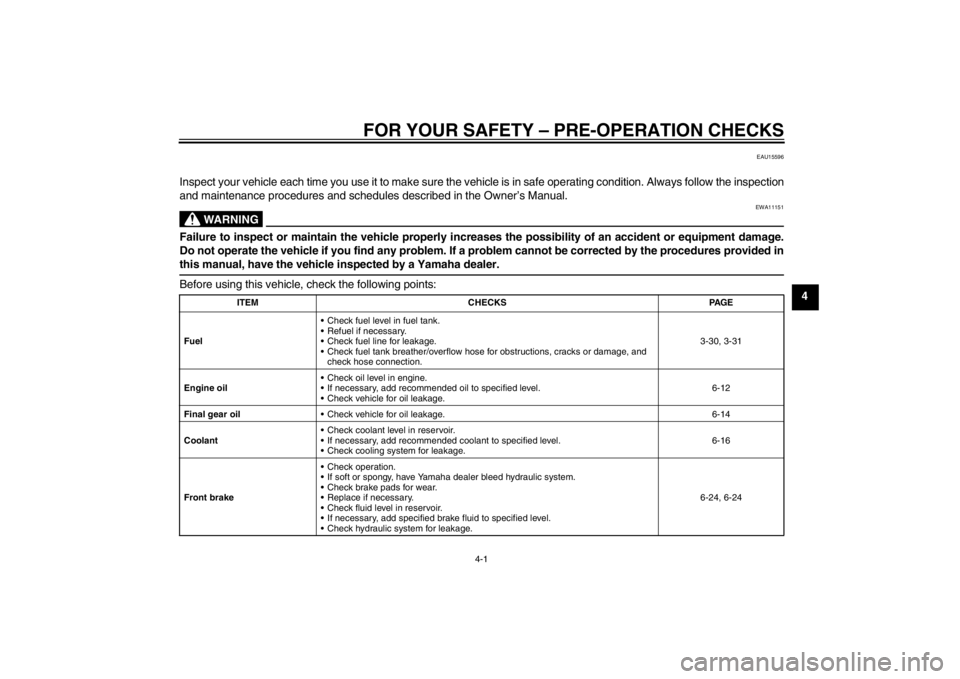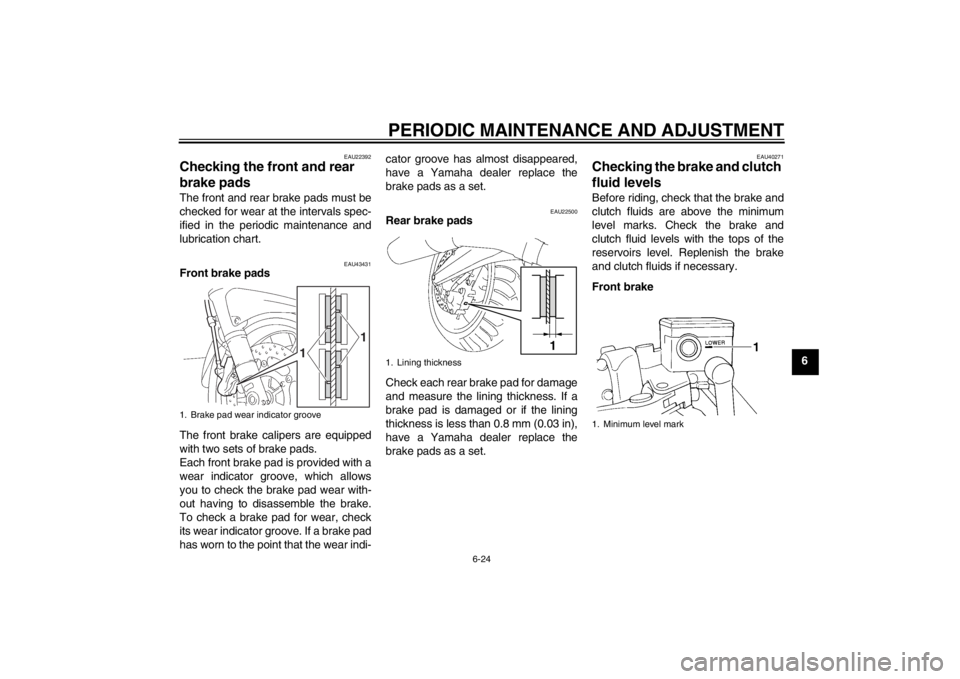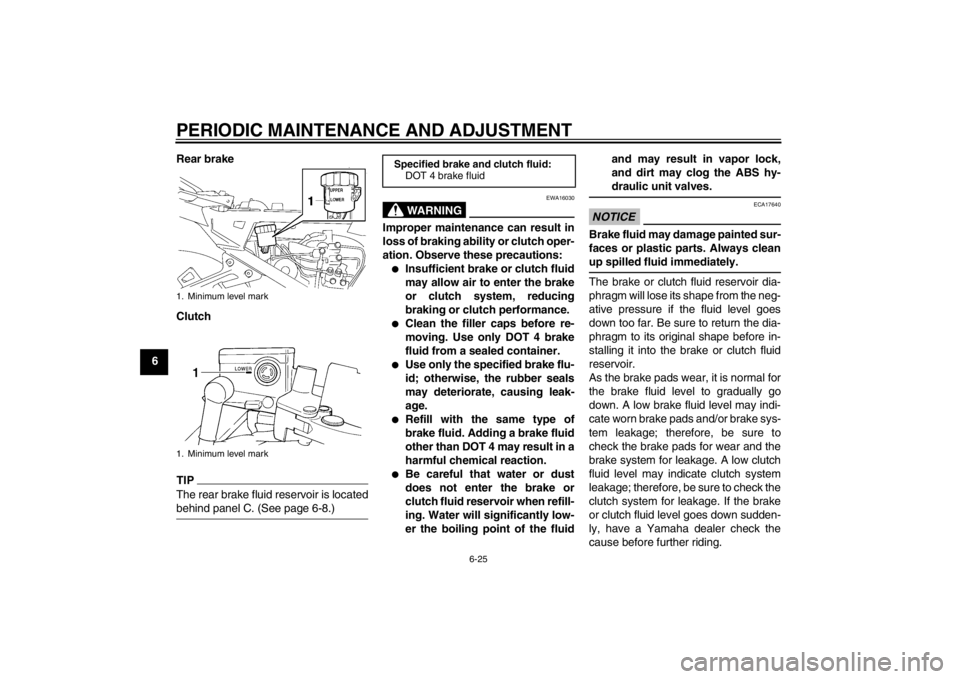brake fluid YAMAHA FJR1300A 2013 Owners Manual
[x] Cancel search | Manufacturer: YAMAHA, Model Year: 2013, Model line: FJR1300A, Model: YAMAHA FJR1300A 2013Pages: 118, PDF Size: 3.28 MB
Page 6 of 118

TABLE OF CONTENTSSAFETY INFORMATION ..................1-1
DESCRIPTION ..................................2-1
Left view ..........................................2-1
Right view ........................................2-2
Controls and instruments.................2-3
INSTRUMENT AND CONTROL
FUNCTIONS .......................................3-1
Immobilizer system .........................3-1
Main switch/steering lock ................3-2
Indicator lights and warning lights ............................................3-4
Cruise control system .....................3-6
Multi-function meter unit .................3-9
D-mode (drive mode) ....................3-22
Handlebar switches ......................3-23
Clutch lever ...................................3-25
Shift pedal .....................................3-25
Brake lever ...................................3-26
Brake pedal ..................................3-26
ABS ..............................................3-26
Traction control system ................3-27
Fuel tank cap ................................3-29
Fuel ...............................................3-30
Fuel tank breather/overflow
hose ..........................................3-31
Catalytic converters ......................3-31
Seats ............................................3-32
Adjusting the rider seat height ......3-33
Storage compartments .................3-35 Accessory box .............................. 3-36
Adjusting the headlight beams ..... 3-37
Handlebar position ....................... 3-37
Opening and closing the cowling
vents ......................................... 3-37
Rear view mirrors ......................... 3-39
Adjusting the front fork ................. 3-39
Adjusting the shock absorber assembly ................................... 3-41
Sidestand ..................................... 3-42
Ignition circuit cut-off system ........ 3-43
Auxiliary DC jack .......................... 3-45
FOR YOUR SAFETY –
PRE-OPERATION CHECKS ............. 4-1
OPERATION AND IMPORTANT
RIDING POINTS ................................. 5-1
Starting the engine ......................... 5-1
Shifting ........................................... 5-2
Tips for reducing fuel consumption ............................... 5-3
Engine break-in .............................. 5-3
Parking ........................................... 5-4
PERIODIC MAINTENANCE AND
ADJUSTMENT ................................... 6-1
Owner’s tool kit ............................... 6-2
Periodic maintenance chart for the emission control system ............. 6-3 General maintenance and
lubrication chart .......................... 6-4
Removing and installing panels ..... 6-8
Checking the spark plugs ............ 6-11
Engine oil and oil filter cartridge ... 6-12
Final gear oil ................................ 6-14
Coolant ........................................ 6-16
Cleaning the air filter element ...... 6-17
Checking the engine idling speed ........................................ 6-18
Checking the throttle grip free
play ........................................... 6-19
Valve clearance ........................... 6-19
Tires ............................................. 6-19
Cast wheels ................................. 6-22
Clutch lever .................................. 6-22
Checking the brake lever free play ........................................... 6-23
Brake light switches ..................... 6-23
Checking the front and rear brake pads .......................................... 6-24
Checking the brake and clutch fluid levels ................................. 6-24
Changing the brake and clutch fluids ......................................... 6-26
Checking and lubricating the
cables ....................................... 6-26
Checking and lubricating the throttle grip and cable ............... 6-26
Checking and lubricating the brake and shift pedals .............. 6-27U1MCE0E0.book Page 1 Thursday, July 19, 2012 6:59 PM
Page 14 of 118

DESCRIPTION
2-2
2
EAU10420
Right view
8
910116,7
5
3,42
1
1. Storage compartment (page 3-35)
2. Fuel tank cap (page 3-29)
3. Front fork spring preload adjusting bolt (page 3-39)
4. Front fork rebound damping fo rce adjusting knob (page 3-39)
5. Windshield (page 3-12)
6. Fuses (page 6-32)
7. Battery (page 6-31)
8. Front fork compression damping force adjusting screw (page 3-39) 9. Brake pedal (page 3-26)
10.Shock absorber assembly
rebound damping force adjusting knob
(page 3-41)
11.Rear brake fluid reservoir (page 6-24)U1MCE0E0.book Page 2 Thursday, July 19, 2012 6:59 PM
Page 15 of 118

DESCRIPTION
2-3
2
EAU10430
Controls and instruments
12 3 4 56
78 2 910,11
12
11
1. Clutch lever (page 3-25)
2. Rear view mirror (page 3-39)
3. Left handlebar switches (page 3-23)
4. Clutch fluid reservoir (page 6-24)
5. Multi-function meter unit (page 3-9)
6. Main switch/steering lock (page 3-2)
7. Front brake fluid reservoir (page 6-24)
8. Right handlebar switches (page 3-23) 9. Brake lever (page 3-26)
10.Throttle grip (page 6-19)
11.Grip warmer (page 3-12)
12.Headlight beam adjusting knob (page 3-37)
U1MCE0E0.book Page 3 Thursday, July 19, 2012 6:59 PM
Page 61 of 118

FOR YOUR SAFETY – PRE-OPERATION CHECKS
4-1
4
EAU15596
Inspect your vehicle each time you use it to make sure the vehicle is in safe operating condition. Always follow the inspection
and maintenance procedures and schedules described in the Owner’s Manual.
WARNING
EWA11151
Failure to inspect or maintain the vehicle properly increases the possibility of an accident or equipment damage.
Do not operate the vehicle if you find any problem. If a problem cannot be corrected by the procedures provided in
this manual, have the vehicle inspected by a Yamaha dealer.Before using this vehicle, check the following points:
ITEMCHECKS PAGE
Fuel Check fuel level in fuel tank.
Refuel if necessary.
Check fuel line for leakage.
Check fuel tank breather/overflow hose for obstructions, cracks or damage, and
check hose connection. 3-30, 3-31
Engine oil Check oil level in engine.
If necessary, add recommended oil to specified level.
Check vehicle for oil leakage. 6-12
Final gear oil Check vehicle for oil leakage. 6-14
Coolant Check coolant level in reservoir.
If necessary, add recommended coolant to specified level.
Check cooling system for leakage. 6-16
Front brake Check operation.
If soft or spongy, have Yamaha dealer bleed hydraulic system.
Check brake pads for wear.
Replace if necessary.
Check fluid level in reservoir.
If necessary, add specified brake fluid to specified level.
Check hydraulic system for leakage. 6-24, 6-24
U1MCE0E0.book Page 1 Thursday, July 19, 2012 6:59 PM
Page 62 of 118

FOR YOUR SAFETY – PRE-OPERATION CHECKS
4-2
4
Rear brake Check operation.
If soft or spongy, have Yamaha dealer bleed hydraulic system.
Check brake pads for wear.
Replace if necessary.
Check fluid level in reservoir.
If necessary, add specified brake fluid to specified level.
Check hydraulic system for leakage. 6-24, 6-24
Clutch Check operation.
If soft or spongy, have Yamaha dealer bleed hydraulic system.
Check fluid level in reservoir.
If necessary, add specified brake fluid to specified level.
Check hydraulic system for leakage. 6-22, 6-24
Throttle grip Make sure that operation is smooth.
Check throttle grip free play.
If necessary, have Yamaha dealer adjust throttle grip free play and lubricate cable
and grip housing. 6-19, 6-26
Control cables Make sure that operation is smooth.
Lubricate if necessary. 6-26
Wheels and tires Check for damage.
Check tire condition and tread depth.
Check air pressure.
Correct if necessary.
6-19, 6-22
Brake and shift pedals Make sure that operation is smooth.
Lubricate pedal pivoting points if necessary.
6-27
Brake and clutch levers Make sure that operation is smooth.
Lubricate lever pivoting points if necessary. 6-27
Centerstand, sidestand Make sure that operation is smooth.
Lubricate pivots if necessary.
6-28
Chassis fasteners Make sure that all nuts, bolts and screws are properly tightened.
Tighten if necessary.
—
ITEM CHECKS PAGE
U1MCE0E0.book Page 2 Thursday, July 19, 2012 6:59 PM
Page 71 of 118

PERIODIC MAINTENANCE AND ADJUSTMENT
6-4
6
EAU1770F
General maintenance and lubrication chart NO. ITEM CHECK OR MAINTENANCE JOB ODOMETER READING
ANNUAL
CHECK
1000 km
(600 mi) 10000 km
(6000 mi) 20000 km
(12000 mi) 30000 km
(18000 mi) 40000 km
(24000 mi)
1 Air filter element Clean.
√√
Replace. √√
2 *Clutch Check operation, fluid level and
vehicle for fluid leakage. √√√√√
3 *Front brake Check operation, fluid level and
vehicle for fluid leakage. √√√√√√
Replace brake pads. Whenever worn to the limit
4 *Rear brake Check operation, fluid level and
vehicle for fluid leakage. √√√√√√
Replace brake pads. Whenever worn to the limit
5 *Brake hoses Check for cracks or damage.
Check for correct routing and
clamping. √√√√√
Replace. Every 4 years
6 *Brake fluid Replace. Every 2 years
7 *Wheels Check runout and for damage. √√√√
8 *Tires Check tread depth and for dam-
age.
Replace if necessary.
Check air pressure.
Correct if necessary. √√√√√
9 *Wheel bearings Check bearing for looseness or
damage. √√√√
U1MCE0E0.book Page 4 Thursday, July 19, 2012 6:59 PM
Page 74 of 118

PERIODIC MAINTENANCE AND ADJUSTMENT
6-7
6
EAU17670
TIP●
The air filter needs more frequent service if you are riding in unusually wet or dusty areas.
●
Hydraulic brake and clutch service Regularly check and, if necessary, correct the brake and clutch fluid levels.
Every two years replace the internal components of the brake master cylinders and calipers as well as clutch master and release cylinders, and change the brake and clutch fluids.
Replace the brake and clutch hoses every four years and if cracked or damaged.
U1MCE0E0.book Page 7 Thursday, July 19, 2012 6:59 PM
Page 91 of 118

PERIODIC MAINTENANCE AND ADJUSTMENT
6-24
6
EAU22392
Checking the front and rear
brake pads The front and rear brake pads must be
checked for wear at the intervals spec-
ified in the periodic maintenance and
lubrication chart.
EAU43431
Front brake pads
The front brake calipers are equipped
with two sets of brake pads.
Each front brake pad is provided with a
wear indicator groove, which allows
you to check the brake pad wear with-
out having to disassemble the brake.
To check a brake pad for wear, check
its wear indicator groove. If a brake pad
has worn to the point that the wear indi-cator groove has almost disappeared,
have a Yamaha dealer replace the
brake pads as a set.
EAU22500
Rear brake pads
Check each rear brake pad for damage
and measure the lining thickness. If a
brake pad is damaged or if the lining
thickness is less than 0.8 mm (0.03 in),
have a Yamaha dealer replace the
brake pads as a set.
EAU40271
Checking the brake and clutch
fluid levels Before riding, check that the brake and
clutch fluids are above the minimum
level marks. Check the brake and
clutch fluid levels with the tops of the
reservoirs level. Replenish the brake
and clutch fluids if necessary.
Front brake
1. Brake pad wear indicator groove
1
1
1. Lining thickness
1
1. Minimum level mark
U1MCE0E0.book Page 24 Thursday, July 19, 2012 6:59 PM
Page 92 of 118

PERIODIC MAINTENANCE AND ADJUSTMENT
6-25
6Rear brake
Clutch
TIPThe rear brake fluid reservoir is located
behind panel C. (See page 6-8.)
WARNING
EWA16030
Improper maintenance can result in
loss of braking ability or clutch oper-
ation. Observe these precautions:●
Insufficient brake or clutch fluid
may allow air to enter the brake
or clutch system, reducing
braking or clutch performance.
●
Clean the filler caps before re-
moving. Use only DOT 4 brake
fluid from a sealed container.
●
Use only the specified brake flu-
id; otherwise, the rubber seals
may deteriorate, causing leak-
age.
●
Refill with the same type of
brake fluid. Adding a brake fluid
other than DOT 4 may result in a
harmful chemical reaction.
●
Be careful that water or dust
does not enter the brake or
clutch fluid reservoir when refill-
ing. Water will significantly low-
er the boiling point of the fluid and may result in vapor lock,
and dirt may clog the ABS hy-
draulic unit valves.
NOTICE
ECA17640
Brake fluid may damage painted sur-
faces or plastic parts. Always clean
up spilled fluid immediately.The brake or clutch fluid reservoir dia-
phragm will lose its shape from the neg-
ative pressure if the fluid level goes
down too far. Be sure to return the dia-
phragm to its original shape before in-
stalling it into the brake or clutch fluid
reservoir.
As the brake pads wear, it is normal for
the brake fluid level to gradually go
down. A low brake fluid level may indi-
cate worn brake pads and/or brake sys-
tem leakage; therefore, be sure to
check the brake pads for wear and the
brake system for leakage. A low clutch
fluid level may indicate clutch system
leakage; therefore, be sure to check the
clutch system for leakage. If the brake
or clutch fluid level goes down sudden-
ly, have a Yamaha dealer check the
cause before further riding.
1. Minimum level mark
1. Minimum level mark
Specified brake and clutch fluid:
DOT 4 brake fluid
U1MCE0E0.book Page 25 Thursday, July 19, 2012 6:59 PM
Page 93 of 118

PERIODIC MAINTENANCE AND ADJUSTMENT
6-26
6
EAU22752
Changing the brake and
clutch fluids Have a Yamaha dealer change the
brake and clutch fluids at the intervals
specified in the periodic maintenance
and lubrication chart or in the TIP after
the periodic maintenance and lubrica-
tion chart. In addition, have the oil seals
of the brake and clutch master cylin-
ders and calipers as well as the brake
and clutch hoses replaced at the inter-
vals listed below or whenever they are
damaged or leaking.●
Oil seals: Replace every two
years.
●
Brake and clutch hoses: Replace
every four years.
EAU23095
Checking and lubricating the
cables The operation of all control cables and
the condition of the cables should be
checked before each ride, and the ca-
bles and cable ends should be lubricat-
ed if necessary. If a cable is damaged
or does not move smoothly, have a
Yamaha dealer check or replace it.
WARNING! Damage to the outer
housing of cables may result in in-
ternal rusting and cause interfer-
ence with cable movement. Replace
damaged cables as soon as possi-
ble to prevent unsafe conditions.[EWA10711]EAU23114
Checking and lubricating the
throttle grip and cable The operation of the throttle grip should
be checked before each ride. In addi-
tion, the cable should be lubricated by a
Yamaha dealer at the intervals speci-
fied in the periodic maintenance chart.
The throttle cable is equipped with a
rubber cover. Make sure that the cover
is securely installed. Even though the
cover is installed correctly, it does not
completely protect the cable from water
entry. Therefore, use care not to pour
water directly onto the cover or cable
when washing the vehicle. If the cable
or cover becomes dirty, wipe clean with
a moist cloth.
Recommended lubricant:
Yamaha Chain and Cable Lube or
engine oil
U1MCE0E0.book Page 26 Thursday, July 19, 2012 6:59 PM